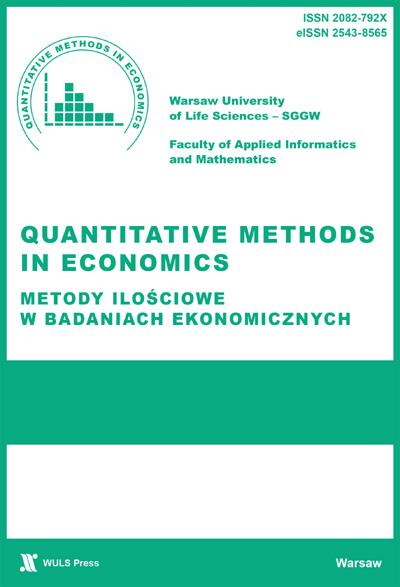SHORT TERM AGGREGATED SUPPLY CURVES FOR OECD COUNTRIES IN 1991 – 2013
Main Article Content
Abstrakt
Politicians used to determine such macroeconomic targets as GDP growth rate, inflation rate, unemployment rate. They are interested in relationships between: unemployment rate and GDP growth rate (the Okun’s law), unemployment rate and inflation rate (the Philips curve) as well as between inflation rate and GDP growth rate (aggregate supply curve - SAS), put forth directly, eg. a straight line or a parabola, or indirectly, i.e. as a function Okun’s with inserted Philips function. SAS derived from the Okun’s and Philips curves estimated for OECD countries in the period 1991 to 2013 are analysed vis a vis curves reflecting direct relationships.
Article Details
Jak cytować
Błaszczuk, D. J. (2015). SHORT TERM AGGREGATED SUPPLY CURVES FOR OECD COUNTRIES IN 1991 – 2013. Metody Ilościowe W Badaniach Ekonomicznych, 16(1), 37–52. Pobrano z https://qme.sggw.edu.pl/article/view/3751
Statystyki
Downloads
Download data is not yet available.
Rekomendowane teksty
Podobne artykuły
- Aleksandra Baszczyńska, BIAS REDUCTION IN KERNEL ESTIMATOR OF DENSITY FUNCTION IN BOUNDARY REGION , Metody Ilościowe w Badaniach Ekonomicznych: Tom 16 Nr 1 (2015)
Możesz również Rozpocznij zaawansowane wyszukiwanie podobieństw dla tego artykułu.
Inne teksty tego samego autora
- Dariusz J. Błaszczuk, Okun’s Law in OECD Countries in 1990 – 2013 , Metody Ilościowe w Badaniach Ekonomicznych: Tom 15 Nr 2 (2014)
Licencja
Publikowane artykuły dostępne są na warunkach Open Access na zasadach licencji Creative Commons CC BY-NC – do celów niekomercyjnych udostępnione materiały mogą być kopiowane, drukowane i rozpowszechniane. Autorzy ponoszą opłatę za opublikowanie artykułu.

